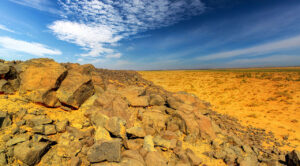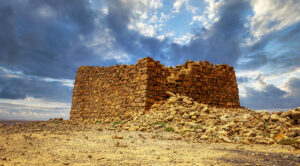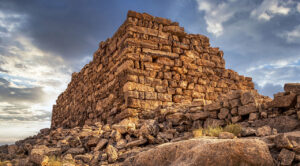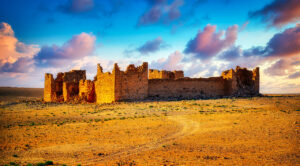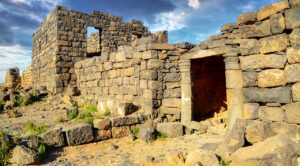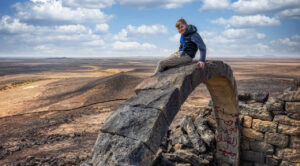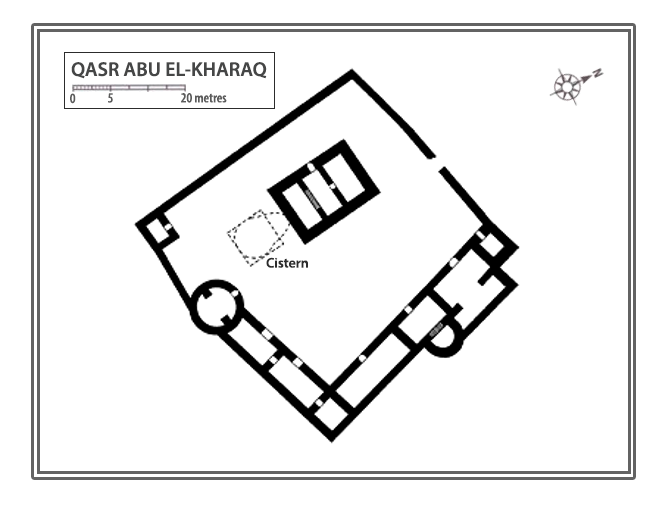Qasr Abu el-Kharaq is a remarkable archaeological site that encapsulates both the ingenuity and strategic importance of ancient desert fortifications. Originally part of the defensive network of the Nabataean Kingdom (150 BC – 105 AD) and later adopted by the Roman army to secure the eastern desert frontier of their Arabia province, this imposing watchtower played a critical role in the Limes Arabicus fortification system.
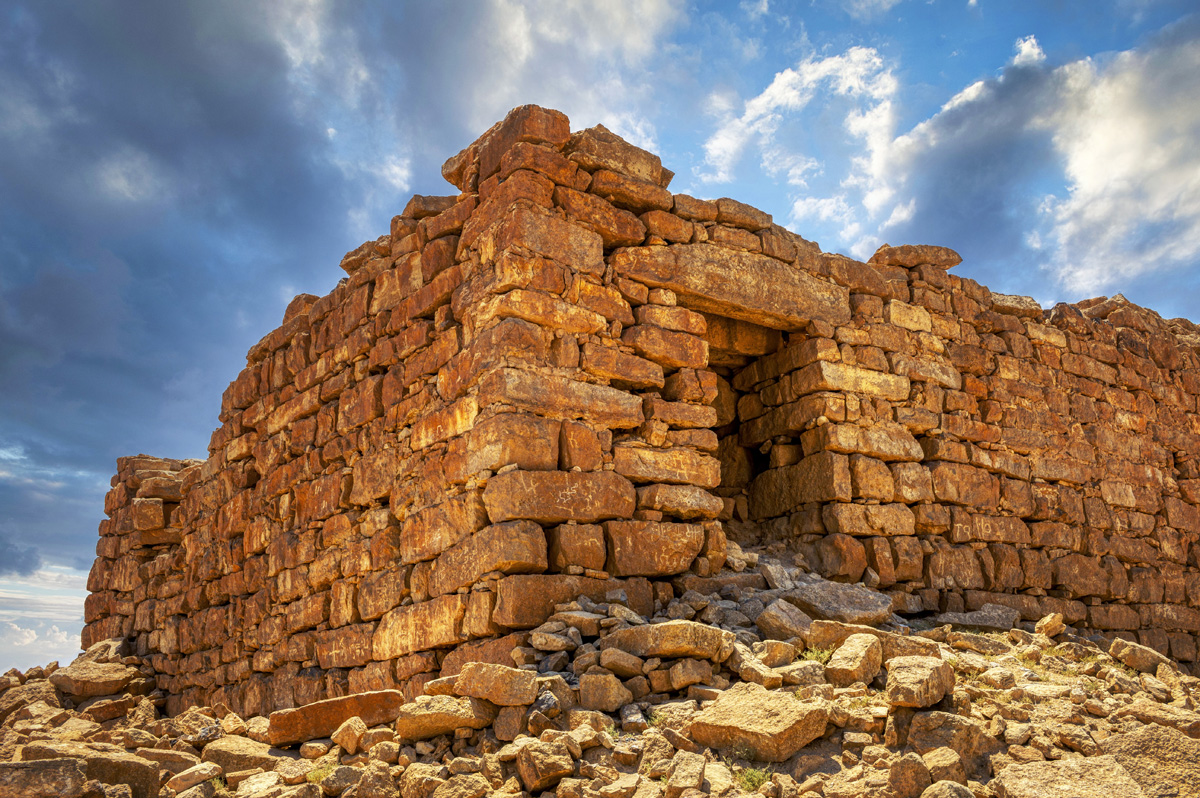
Location and Landscape
Perched on a hill approximately 3 km northwest of Qasr Bshir, the watchtower offers a panoramic view of a breathtakingly expansive landscape. This region of Jordan, stretching across a staggering 8,000 square kilometres, is defined by gently rolling plains crisscrossed by shallow wadis. These wadis, which channel the scarce desert rainfall westward into the Wadi Mujib, create a unique interplay of rugged natural beauty and barren desert mystery, perfect for exploration and contemplation.
Architectural Features
The structure of Qasr Abu el-Kharaq is both functional and captivating. The rectangular tower spans 22 × 18 metres and is oriented south-southwest to north-northeast. One of its most striking features is the inward-sloping external walls, a clever architectural element that bolsters structural stability. On the northern outer wall, an entryway—still intact to this day—offers a glimpse into the ingenious design. Elevated slightly above ground level, this entrance, as noted by biblical archaeologist Nelson Glueck (1900–1971), suggests the possible existence of steps or a platform originally leading up to it.
At its most well-preserved section, the northern corner, Glueck recorded the tower reaching a height of over eight metres, with 22 layers of stonework still visible. The masonry itself exhibits impressive craftsmanship, comprising hand-cut quarry stones set irregularly yet exhibiting durability. Glueck also discovered remnants of plaster on the south side of the tower, indicating that the walls were originally covered to fill the joints between the stones and protect against weathering.
At the crucial junctions, the corners were reinforced with specially cut stones, a testament to the engineering prowess of the builders.
Mysterious Underground Corridor
The western outer wall of the tower holds a tantalising piece of history. Near its southern end, an opening leads to a subterranean passageway, designed to extend north. This enigmatic feature, blocked further along by debris, invites speculation about its original purpose, whether for storage, escape or as part of a larger network of defensive innovations.
The Enclosure and Older Structures
Surrounding the tower on three sides is the faint outline of what was once a large enclosure, measuring approximately 60 × 60 metres. British archaeologist David Leslie Kennedy later determined that the watchtower was constructed within an existing older structure, its northern wall placed against the enclosure’s boundary. These layers of occupation add depth to the site’s story, blending Nabataean ingenuity with Roman military strategy.
Visiting Qasr Abu el-Kharaq Today
For modern adventurers and history enthusiasts, Qasr Abu el-Kharaq is accessible via 4×4 or crossover vehicles, making it one of the most intriguing stops for those exploring the Desert Highway. Its proximity to Qasr Bshir and Qasr el-Al also opens the door for an immersive day of historical exploration. Standing atop the hill, with its commanding view of the desert expanse, visitors can feel the echoes of ancient times. And if you happen to stumble upon scattered bones during your visit, worry not—they are typically relics of desert fauna, further adding to the site’s rugged allure.
Qasr Abu el-Kharaq is more than just an architectural marvel; it is a portal into the past—an enduring testament to the creativity, strategy, and resourcefulness of the Nabataeans and Romans. Whether you are a history buff, an archaeology enthusiast, or simply someone drawn to the stories etched in stone, this desert watchtower promises an unforgettable encounter with millennia-old history.
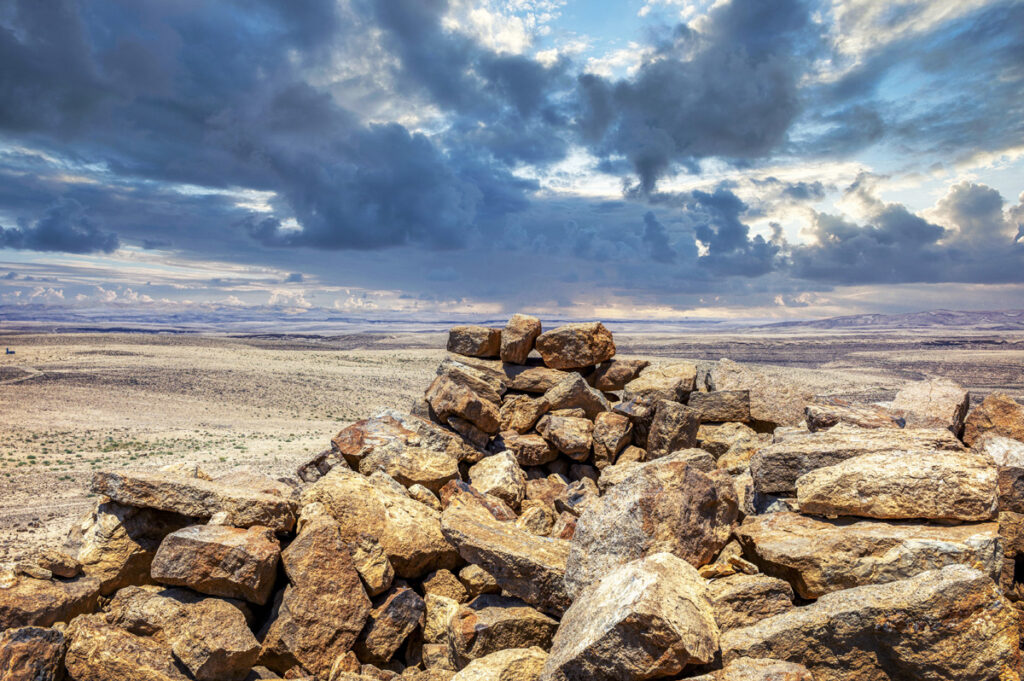
The Roman watchtower, constructed in the 4th century AD, was strategically built against the northern wall of an earlier, larger Nabatean settlement. This impressive structure served as a defensive outpost, standing resolute through centuries of historical shifts.
One of its earliest recorded visitors was the renowned biblical archaeologist Nelson Glueck (1900–1971). During his explorations of the Roman Limes in Jordan in the late 1930s, Glueck briefly studied this ancient site in 1936. Although his visit was short, Glueck’s observations began to shed light on the significance of the region. Interestingly, for much of the 20th century, the Roman frontier in modern-day Jordan remained one of the most understudied borders of the Empire—until the early 1980s.
It was Samuel Thomas Parker, an American archaeologist specialising in provincial Roman studies, who pioneered much of the modern research into the late antique Limes Arabicus. Leading the Limes Arabicus Project between 1980 and 1989, Parker and his team conducted extensive archaeological expeditions, focusing in particular on the Roman frontier in central Jordan. His work unveiled a wealth of insights into the intricacies of these ancient borderlands.
Glueck’s findings at the site included fragments of Nabatean pottery, such as a piece of sigillata, a type of fine, red-gloss ceramic. The scattered shards told tales of a varied history—ranging from the Iron Age II (1000–586 BC) through the Nabatean and early Roman periods. What’s even more fascinating is that the watchtower saw intermittent use throughout late Roman and Byzantine times, standing as a testament to its enduring value and the layers of history it embodies.
Today, this watchtower holds an important place in unravelling the border dynamics of Roman and Nabatean civilisations. Its continued rediscovery allows us to piece together the echoes of people who lived, guarded, and traversed these lands long ago.
